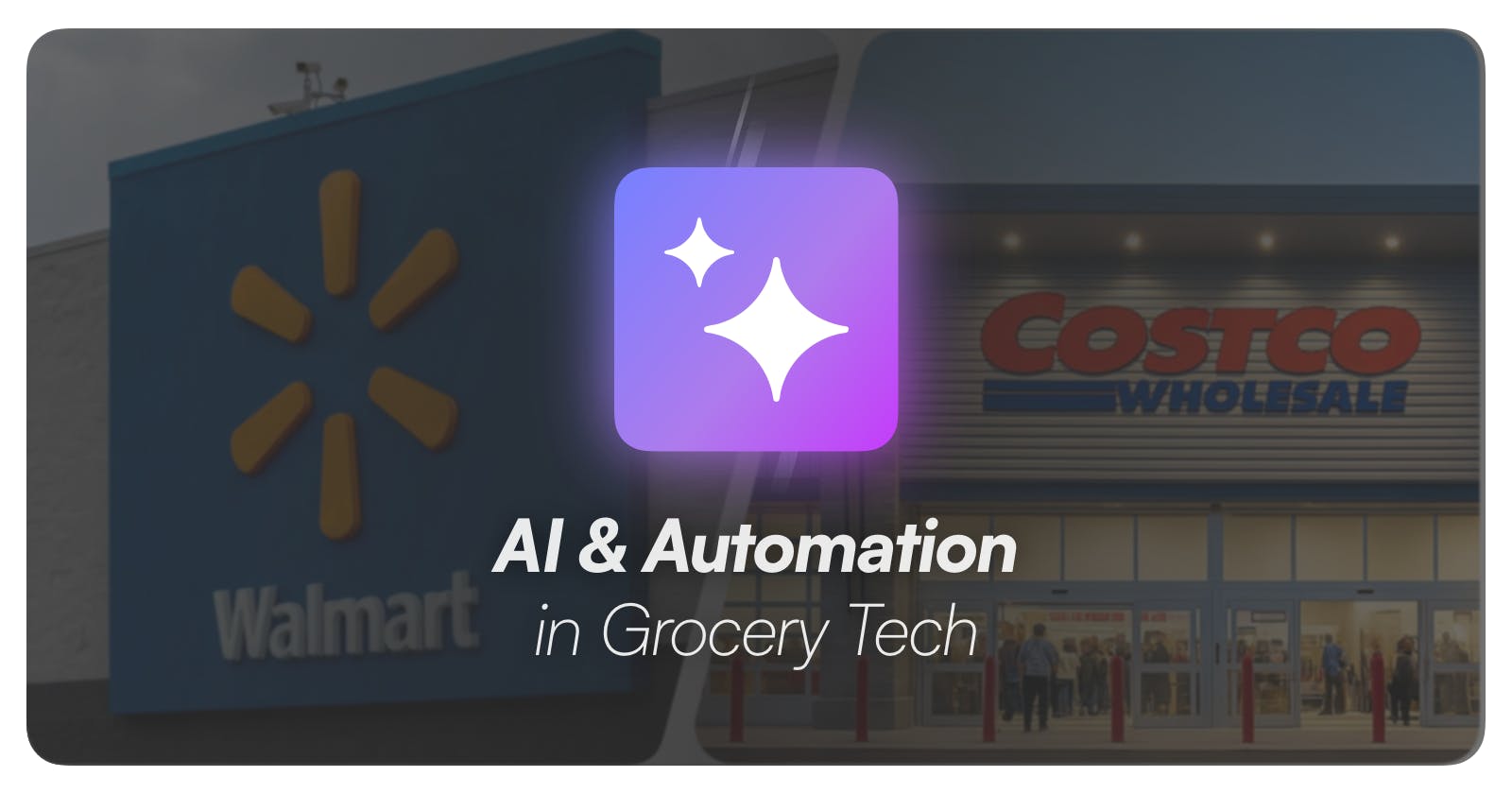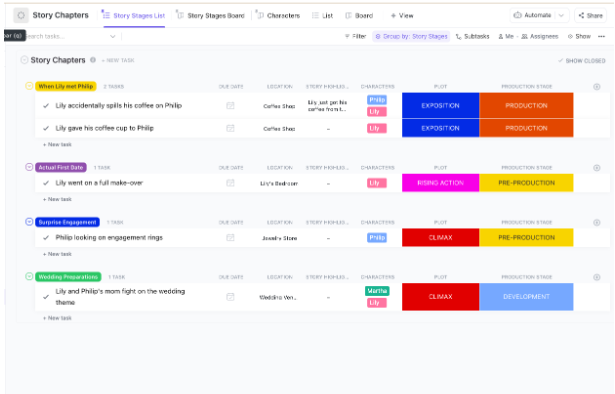The COVID-19 pandemic was a major turning point for the world of commerce. Online retail sales took off, jumping from 11% of total sales in Q4 2019 to 15% in Q4 2020. Since then, using technology has become essential to staying competitive—especially in the food retail space.
Nowhere is this shift more pronounced than in food retail, where U.S. grocers are dealing with global challenges: supply chain issues sparked by the pandemic, the war in Ukraine, and growing trade tensions. What strategies are the biggest retailers using to remain competitive?
In this article, we’ll look at how major U.S. food retailers Walmart and Costco are using technology, AI and automation to improve their supply chains and inventory systems—so they can keep shelves stocked, serve customers better, and stay ahead of the competition.
──────────────────────────────────────────────────
Walmart: The Leader in Tech-Driven Retail
The U.S. food retail space is led by four key players: Walmart, Costco, Kroger, and Target. Among them, Walmart stands out for its consistent investment in tech infrastructure and testing new digital initiatives. Long before the pandemic, the company had begun evolving into a technology-led retailer—developing automation systems, expanding R&D, and upgrading its fulfillment network.
For Walmart, the recent years have meant addressing multiple challenges at once:
▶︎ Meeting the demands of omnichannel customer expectations
▶︎ Navigating trade regulations that impact costs, pricing, and margins
▶︎ Mitigating supply chain disruptions
▶︎ Adapting to shifting consumer behavior under inflation
From a shopper’s perspective, features like curbside pickup, Scan & Go, and reliable online delivery show how Walmart integrates tech into the customer experience. But the bigger story lies behind the scenes.
To support that front-end experience at scale, Walmart is transforming the way it handles inventory, fulfillment, and delivery—with an emphasis on three priorities:
- Inventory forecasting through machine learning to improve accuracy
- Automation in fulfillment operations to increase speed, efficiency, and safety
- Hyperlocal fulfillment using Market Fulfillment Centers (MFCs) to shorten delivery times and reduce store strain
──────────────────────────────────────────────────
1. Inventory Forecasting Through Machine Learning
Since at least 2021, Walmart has been investing heavily in data analytics.
“We see more than 10,000 inventory events per second at Walmart. To make sense of it all, we use machine learning to help every store predict its unique inventory trends,” – EVP at Walmart Global Tech Srini Venkatesan
In 2023, the company rolled out the Centralized Forecasting Service (CFS) at Sam’s Club. CFS replaces disconnected systems with a shared forecasting platform used across teams like merchandising, logistics, and planning.
“The models are based on a simple assumption that we can predict the future by analyzing the past. Being able to forecast and make accurate predictions are obviously essential for retailers to make timely decisions that maximize profit, reduce cost and improve customer satisfaction.”
In 2024, Walmart launched Element, its internal machine learning platform. Designed to solve the company’s data challenges without relying on external vendors, Element supports:
- Search optimization: Improves ranking based on user context and seasonal trends
- Dynamic pricing: Monitors competitor pricing and local demand
- Sales analytics: Processes large datasets to inform inventory planning
- Last-mile delivery: Predicts efficient routes using real-time traffic and location data
Element also powers Walmart’s intelligent driver dispatch system. It helps optimize delivery routes for drivers, especially in regard with traffic conditions and order cancellations.
These are just the use cases Walmart has shared publicly. But with a machine learning engine this robust, it’s clear the impact reaches far beyond. Behind the scenes, Element is likely solving a wide range of challenges in ways we don’t yet see.
2. Optimization of Fulfillment Operations
In addition to machine learning, Walmart has invested in automation across its fulfillment and distribution centers. These next-gen facilities feature robotics, dense storage, and advanced logistics—shifting away from traditional warehouse setups.
“Modernizing applications across the centers has resulted in positive, people-focused outcomes, such as improved productivity, a more efficient materials flow, and a safer operating environment for our associates,” said Shwati Mohapatra of Walmart’s U.S. Omni Tech team.
While the company hasn’t shared exact figures, it reports major improvements:
- Order Speed: Fulfillment occurs within hours of order placement.
- Process Efficiency: Manual 12-step workflows have been reduced to just five steps.
- Storage Capacity: Storage doubled through smarter layout and automation.
- Time Savings: Automation reduced the distance associates walk by up to 9 miles per day.
Interestingly, Walmart found that “motion waste,” unnecessary movement during order picking, contributes to fulfillment costs significantly.
3. Hyperlocal, High-Speed Fulfillment with MFCs
Walmart’s Market Fulfillment Centers (MFCs) bring automation into stores. These small, robotics-powered facilities are built inside or next to existing locations and focus on online orders for groceries and everyday items.
By co-locating fulfillment with stores, Walmart shortens delivery windows, increases order accuracy, and reduces pressure on store teams. MFCs are a key part of Walmart’s push to deliver speed, convenience, and scale—without compromising accuracy.
These three areas are helping Walmart handle its grocery business. By building tools that tackle real, day-to-day challenges—like forecasting demand, automating warehouses, and streamlining last-mile delivery—the company is improving its operations and staying competitive in a fast-moving retail market.
──────────────────────────────────────────────────
Technology Innovation at Costco
Let’s now turn to Costco–another top food retailer.
Costco is significantly smaller than Walmart in terms of both sales and store count. In 2023, Walmart generated over $533 billion in revenue, while Costco brought in approximately $175 billion. Walmart operated 5,321 stores, compared to Costco’s 587.
The two players have very different business models. Walmart operates a high-volume, mass-market retail model with multiple store formats. In the meantime, Costco focuses on fewer, larger warehouse clubs with a membership-based model and limited SKUs.
Despite its smaller scale, Costco achieves high sales per store—more than triple Walmart’s. Let’s take a look at how:
──────────────────────────────────────────────────
1. Client-Facing Digital Transformation at Costco
Costco and Walmart have taken very different paths when it comes to digital transformation. Costco entered the e-commerce space relatively late, launching its home delivery service, CostcoGrocery, in 2017—alongside a partnership with Instacart to handle perishables and fresh food.
Even since then, e-commerce has not become a central focus for the company. Case in point: Costco’s delivery FAQ emphasizes (more than once) that online prices are higher than in-store.
It almost feels as though Costco is trying to discourage customers from shopping online and instead encourage them to visit its warehouses. 🙂
In contrast, Walmart has leaned hard into e-commerce. By 2023, its online market share was more than four times Costco’s. While Reddit users were calling out Costco’s mobile app for clunky performance, Walmart was running a startup accelerator to improve search and rolling out AI assistants to help both shoppers and employees. At least on the customer-facing side, Walmart has a clear lead in digital.
But what about the supply chain?
2. Costco Supply Chain Innovations
Costco’s distribution network is simpler by design.
The authors of the newsletter “On the Seams” have carefully compiled distribution network maps for both Costco and Walmart, which we are citing here.
Costco operates fewer types of distribution centers compared to Walmart—and fewer of them overall. Many Costco stores double as warehouses, and the company relies on a streamlined cross-docking model: goods move directly from depot to store, skipping long-term storage.
As Hugo Britt from Thomasnet puts it, “Costco’s approach to warehousing and logistics is to use a simple cross-docking system to move freight directly from one of their depots to a truck headed to the warehouse that ordered it.” This lean model cuts down on steps and complexity.
So where does innovation fit into such a streamlined supply chain? That’s a fair question.
▶︎ Fulfillment of Online Orders
One pivotal milestone was Costco’s $1 billion acquisition of Innovel Solutions in 2020. Innovel specialized in last-mile logistics for large items—think couches, treadmills, refrigerators. The acquisition gave Costco control over a national delivery network for big-ticket items, reducing its reliance on third parties and improving delivery speed and consistency.
The company also announced plans to open a new, larger fulfillment center with better infrastructure for e-commerce. So far, those plans haven’t materialized.
▶︎ User Experience Upgrades
Costco has made practical improvements to its mobile app and website. Shoppers can now check in-store inventory in real time, use a digital membership card, and navigate the app more easily. These changes streamline both the front-end experience and back-end operations.
──────────────────────────────────────────────────
Costco vs. Walmart: A Tech Gap
Costco still trails Walmart when it comes to technology—especially in areas like AI. There’s little public evidence of advanced digital initiatives, while Walmart continues to invest heavily in tools that support both customers and employees. That said, Costco shows growth in revenue, profit, and membership.
Costco’s secret sauce might be its disciplined focus on simplicity, efficiency, and trust, rather than chasing every new tech trend. By sticking to what it does best—moving large volumes of a few products through a lean, high-turnover model—Costco generates strong per-location revenue.
These efforts reflect Costco’s pragmatic modernization of their supply chain. Its priorities are cost discipline, operational control, and selective innovation.
──────────────────────────────────────────────────
Conclusion
Even in an era when the hype around AI is pushing companies to make impulsive decisions, some continue to resist the panic and stay the course they originally set. Costco is one such company: lean, disciplined, and focused on doing fewer things exceptionally well. Its strategy favors operational simplicity, customer loyalty and cost efficiency.
Meanwhile, Walmart has transformed into a true tech company. It is implementing AI for demand forecasting, creating new experiences for website visitors, simplifying warehouse operations, and applying machine learning across pricing and delivery logistics.
Ultimately, both companies are playing to their strengths. Walmart leads in tech-driven innovation and omnichannel convenience, while Costco excels in operational discipline and value-driven efficiency. The question isn’t who’s copying whom—it’s whether each model is future-proof in its own right.











